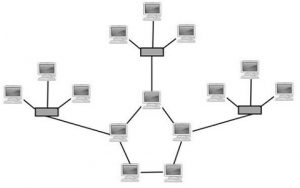
The arrangement of computer networks is known as Topology which is separated into either logical or physical arrangements. Logical topology is the way how the data is flowing within a computer network whereas physical topology is the way how the computers are connected within a network to each other. So computer network topology is the network arrangement that is connected through different nodes using lines of connection. There are different types of network topologies that are used based on the requirement. So this article discusses one of the types of network topology like hybrid topology, working with applications.

A type of network topology that utilizes a minimum of two or above differing network topologies like bus topology, ring topology, mesh topology, tree topology & star topology. So, this topology is the combination of several topologies which forms a resultant topology. The choice of using this topology as compared to other topologies mainly depends on the needs of the users and different factors like the number of computers, desired network performance, location, etc. The hybrid topology diagram is shown below.
In a computer network, we use different kinds of network topologies like Bus, Star, Ring, and Mesh. But, the most frequently used network topology is Hybrid topology because it is the combination of two or more topologies. For instance, if you combine star and ring topology to make a large network through the hubs & switches then it is known as hybrid topology. The structure of the hybrid topology is shown below.
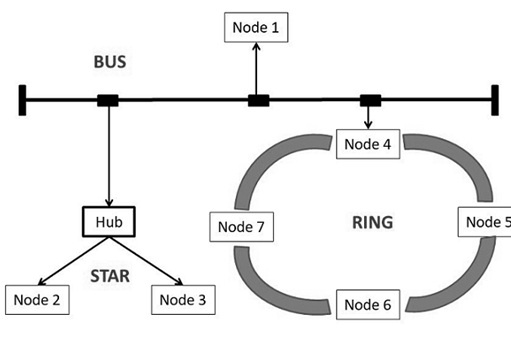
In the above network, two or more network topologies are interconnected and each topology has its own nodes. The resulting interconnection simply allows the nodes within a specified basic topology to communicate with other nodes in a similar basic topology and those in another basic topology in the hybrid network.
In this type of topology, we can select what will be the network backbone like a switch/ hub, and also divisions of the network that mainly vary because of its topological arrangement. The network divisions include the network topologies. The entire computer networking system mainly depends on the backbone of the network that is connected through network segments.
The hybrid network can be arranged at any place easily like a home or office because of the ease of use & flexibility. Because of the hybrid structure, each topology’s overall features are distributed equally in the series of networks which provides the easiest way to identify errors & also assist while doing troubleshooting.
Generally, Hybrid topology in any computer network uses more than one topology. In addition, this topology uses both Wi-Fi (802.11 a/b/g) and Ethernet (802.3) standards for its operations. This network mainly depends on particular hybrid routers like hubs & switches so that it can connect easily with both wireless & wired computers without any difficulty. Its working mechanism of this topology mainly depends on IP Addresses similar to other network topologies. This topology has different network branches and every branch has its own design.
These topologies are classified into three types star-ring, star-bus and hierarchical topologies.
The star-ring hybrid topology can be formed by connecting both the star topology and ring topology. Two or more star topology is connected with the ring topology through the wired connection. This topology is unidirectional & bidirectional, so the data flows in two directions. This topology provides more reliability if any node in the network fails to transmit data & after that other nodes don’t affect it.
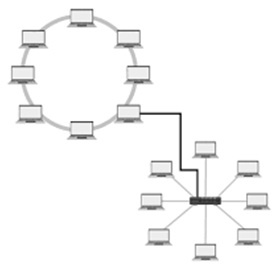
The Star-Bus topology can be formed by connecting both the star and bus topologies through a wired connection. This kind of hybrid topology provides reliability & better throughput. This topology is bidirectional, so data can be transmitted in two directions. In this arrangement, the main bus topology works like a backbone connection to interconnect the star topologies. In this case, the backbone connection is a wired connection.
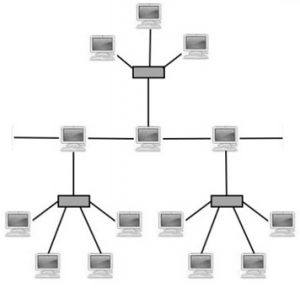
The hierarchical topology is also called tree topology because the hierarchical topology structure is the same as the tree topology. So in this type of topology, the network is combined through a minimum of two or above topologies where the main topology is known as the root node & the next node is known as the child node. This topology is the arrangement of both parent & child networks so it provides the main relationship between parent & child networks. So, this kind of topology provides reliability & maximum throughput.
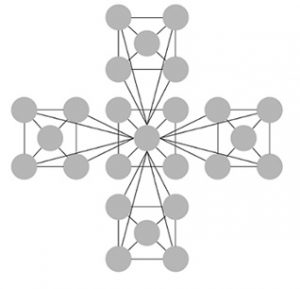
The advantages of hybrid topology are given below.
The disadvantages of hybrid topology are given below.
The applications/uses of hybrid topology are given below.
Thus, this is an overview of hybrid network topology – working with applications. Examples of Hybrid Topology are; star-wired buses and star-wired rings. Here is a question for you, what is ring topology?